Research Article - (2021) Volume 10, Issue 2
Aim: To analyze the influence of heat stable anti-A and anti-B antibodies of the persons with anti-A and anti-B absorbing ability of erythrocytes different from their blood group type on erythrocyte membrane.
Materials and methods: Reaction of hemagglutination with complement at room temperature, 4°C, 37°C with the heated sera, elution and method of absorption were used.
Results: The heated sera of the persons with anti-A and anti-B absorbing abilities of erythrocytes corresponding to their blood group characteristics increased the size of the erythrocytes during incubation with complement at room temperature on the contrary to the heated sera of the persons with absorbing ability of erythrocytes different from their blood group type. The contact of the studied erythrocytes with antihelmintic drug fenbendazole decreased the level of anti-A antibodies obtained by elution after the absorbtion of the person’s erythrocytes with anti-A serum. The person’s serum showed high level of antibodies against Ascaris lumbricoides (1.25 s/co as compared to the normal <1.0 s/co) and Toxocara canis (1.8 s/co, 1:200 as compared to the normal <1.0 s/co).
Conclusion: The heated sera of the persons with different from their blood group type anti-A or anti-B absorbing ability of erythrocytes did not increase the size of erythrocytes so much as compared to the sera of the persons with absorbing ability of erythrocytes corresponding to their blood group type. The decrease of anti-A antibodies in hemagglutination reaction and after elution might be associated with the involvement of hemagglutinins due to Ascaris lumbricoides infection.
Erythrocytes • Hemagglutination • Hemolysis • Anti-A • Anti-B
The cases of absorbing ability of erythrocytes not corresponding to the blood group type of the person presents interest for investigation [1]. Since polysaccharide fractions isolated from various parasites have been shown to be absorbed by erythrocytes and to have the immunological property of inhibiting the α and β isoagglutinins present in human serums it seemed of great interest to carry out the study on the immunological relationship between the absorbing properties of erythrocytes and ability of the serum to influence on erythrocyte membrane as well as absorbing ability of erythrocytes treated with antihelminthic drug fenbendazole and presence of increased antibodies against parasites.
The aim of the study was to analyze the hemolyzing ability of the serum from the persons with anti-A and anti-B absorbing ability of erythrocytes corresponding and not corresponding to their blood group type.
The sera of the persons with O blood group type and anti-A absorbing ability of erythrocytes, A blood group type and anti-B absorbing ability and B blood group type with anti-A absorbing ability were investigated in the reaction of hemagglutination with complement with A and B erythrocytes at 37°C, 4°C and room temperatures and in absorbtion reaction using standard methods [2]. The study was approved by the Kharkiv National Medical University ethics committee. The study is within clinical trial No 01180000929. No funding sources were used in the study.
Case 1
AB+ person: Anti-B serum of A blood group person with anti-B absorbing ability of the erythrocytes did not agglutinate O blood group erythrocytes with anti-A absorbance (OA+) at room temperature showing their diameter 4.0-6.2 μm and at pH 6.0, 8.0. Incubation of the heated serum with A erythrocytes and complement at 37°C did not cause agglutination, the diameter of erythrocytes was measured as 3.7, 4.2, 4.9, 5.6 μm, whereas at room temperature weak agglutination was present with diameter of erythrocytes 7.3, 8.0 μm (Figures 1 and 2) (Table 1). Incubation of the studied serum with A erythrocytes at room temperature caused weak agglutination with diameter of erythrocytes 4.0, 6.2, 5.5 μm. Incubation of the heated serum with B erythrocytes, complement at 37°C showed agglutination with diameter of erythrocytes 4.1, 4.4 μm and at room temperature agglutination appeared with diameter of erythrocytes 6.7 μm. The serum caused hemolysis of B erythrocytes with complement at 37°C, the heated serum induced agglutination and hemolysis of BA+ erythrocytes (with anti-B absorbing ability) (Figures 3 and 4). The contact at 4°C of another person’s anti-B heated serum with A erythrocytes and complement caused weak agglutination and hemolysis, whereas combination of the heated anti-B with the studied serum of AB+ person did not induce agglutination and hemolysis. The serum of BA+ person (B blood group and anti-A absorbing ability of erythrocytes) with A erythrocytes and complement at room temperature showed presence of hemolysis, however when combined with the studied AB+ person’s serum the hemolysis did not occur, similarly combined with the other serum from the case with additional absorbing ability of erythrocytes (from BA+ person) the hemolysis was absent (Figures 5-7). Similarly, incubation of the heated anti-A, B serum with complement agglutinated and hemolysed AB erythrocytes at 4°C, whereas combination with the studied AB+ person’s plasma abolished hemolysis (Figures 8 and 9). The diameter of AB erythrocytes at 4°C was measured as 6.8, 7.2, 7.2 μm, with anti-A, B serum: 6.9, 6.9, 7.6 μm, with the heated anti-A,B serum: 6.6, 6.8, 7.4, 7.5 μm, with the heated anti-A,B serum and complement: 7.2, 8.5, 8.9, 10.4 μm (an increased size), whereas combined with plasma from the studied AB+ person: 5.0, 6.2, 6.2, 8.3 μm (no increase of the size). The serum of AB+ person absorbed B antigen from AB+ person, absorbed A erythrocytes and caused inhibition of hemagglutination on 1 degree. Incubation of the person’s serum after absorbtion with A and B erythrocytes caused weak agglutination of own erythrocytes with the score 1:8.
| Serum | Agglutination at RT | Agglutination with C’ at 37°C | Agglutination with C’ at RT | Agglutination with C’ at 4°C | ||||||||
|---|---|---|---|---|---|---|---|---|---|---|---|---|
| A | OA+ | A | B | BA+ | A | B | O | AB | A | AB | ||
| Anti-B (from AB+) | 4.0, 6.2, 5.5 | +m, 4.0, 6.2, 5.5, 6.0, 8.0: | Hem. | With anti-A (from BA+): The only anti-A (from BA+): hem. The only anti-A (from BA+) and one more anti-A. |
AB er.: 7.2, 6.8 serum from AB: 5.5, 7.2, 5.2) | With heated anti-A,B: 3.6, 5.6 (the only heated anti-A,B: 5.3, 8.7, 8.4) With heated serum from AB: 4.7, 4.3, 8.6 (the only heated the only AB er.: 7.2, 6.8 |
With heated anti-B:- (only the heated anti-B: +m, hem) |
With heated anti-A,B:- (the only heated anti-B: +, hem) The heated anti-A,B with plasma from AB+: 6.2, 8.3, 5.0 (The only heated anti-A,B: 7.2, 8.9, 8.5, 10.5 µm.) with the only AB er.: 7.2, 6.8 |
||||
| Heated anti-B (from AB+) | 5.8, 5.3, 4.9 | -, 4.6, 4.2, 3.7, 4.9; the only A er.: 7.5, 5.6, 6.9, 6.7 | +, 4.1, 4.4; the only B er.:4.7, 7.0, 4.8, 6.6 | +, hem. | +m, 8.0, 7.3; the only er.: 7.5, 5.6 | +, 6.7; the only B er.: 4.7, 4.8 | With plasma: 5.2, 4.7, 4.9 | |||||
Note: er.-Erythrocytes; C’-Complement; hem.-Hemolysis.
Table 1: The case of the person with AB+ blood group type.
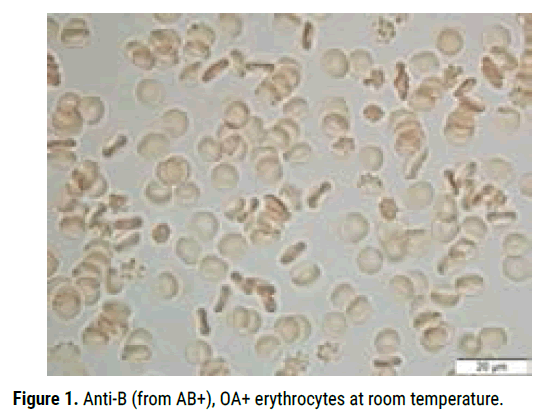
Figure 1: Anti-B (from AB+), OA+ erythrocytes at room temperature.
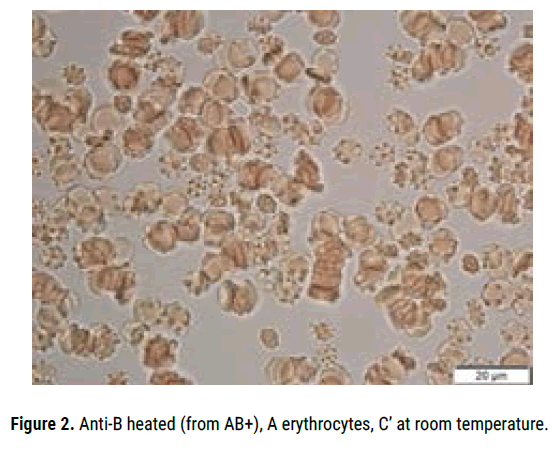
Figure 2: Anti-B heated (from AB+), A erythrocytes, C’ at room temperature.
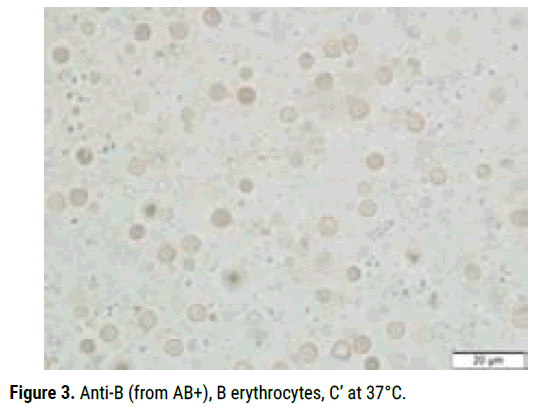
Figure 3: Anti-B (from AB+), B erythrocytes, C’ at 37°C.
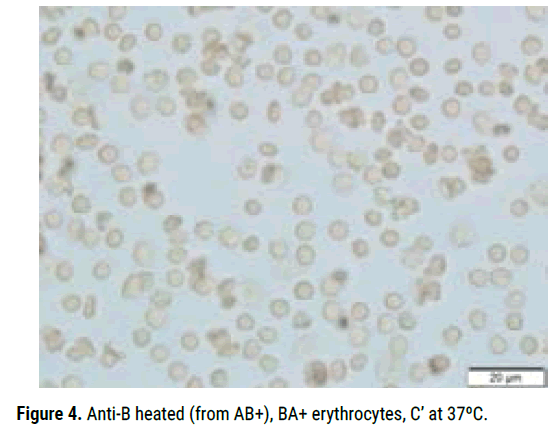
Figure 4: Anti-B heated (from AB+), BA+ erythrocytes, C’ at 37ºC.
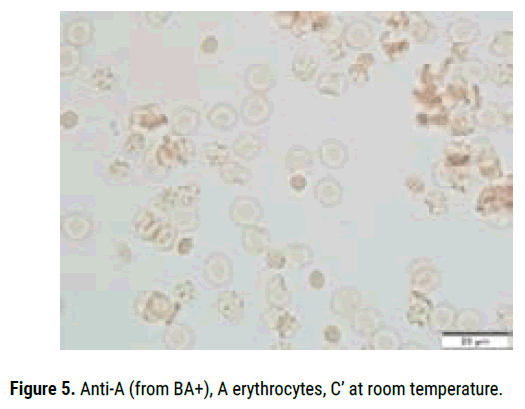
Figure 5: Anti-A (from BA+), A erythrocytes, C’ at room temperature.
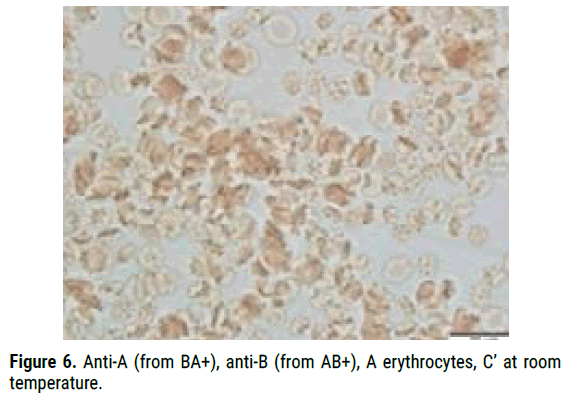
Figure 6: Anti-A (from BA+), anti-B (from AB+), A erythrocytes, C’ at room temperature.
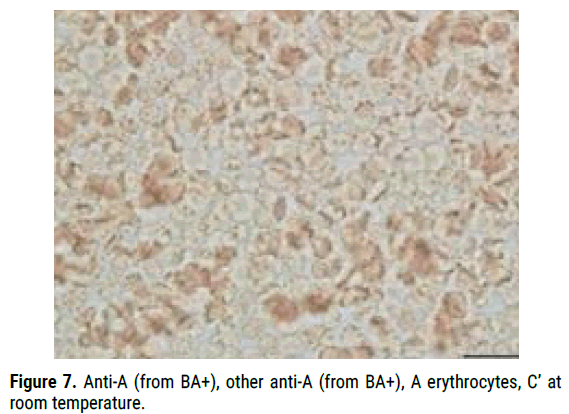
Figure 7: Anti-A (from BA+), other anti-A (from BA+), A erythrocytes, C’ at room temperature.
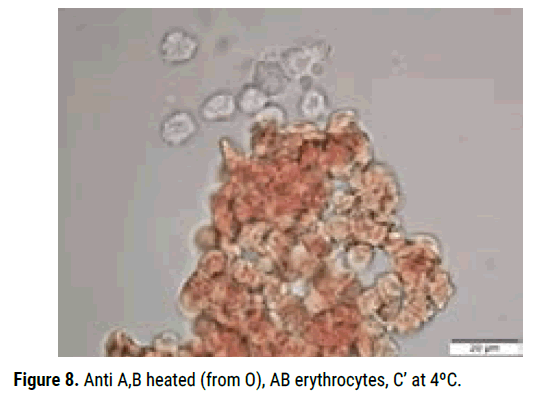
Figure 8: Anti A,B heated (from O), AB erythrocytes, C’ at 4ºC.
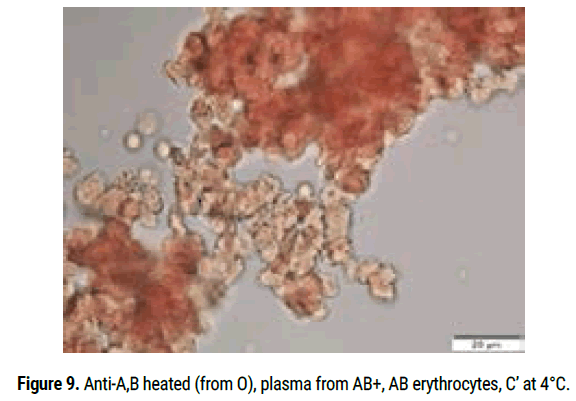
Figure 9: Anti-A,B heated (from O), plasma from AB+, AB erythrocytes, C’ at 4°C.
Case 2
AB+ person: Incubation of anti-B serum from AB+ person (with anti-B absorbing ability of erythrocytes) with OA+ erythrocytes (presence of anti-A absorbing antigens) and complement at 37°C did not induce agglutination, the erythrocytes showed less size and deformations (Table 2). Weak agglutination of erythrocytes appeared after the contact of the studied serum with A erythrocytes and complement at 37°C. Agglutination and hemolysis did not appear after the contact of the serum with OA+ (with anti-A absorbing antigens) erythrocytes and complement. The contact of A erythrocytes at room temperature with complement and the heated serum caused paleness of erythrocytes, tendency to agglutination (Figure 10). The serum agglutinated B erythrocytes with complement at 37°C without hemolysis (Figure 11). The serum did not show inhibition of hemagglutination with AB+ erythrocytes neither with erythrocytes nor with plasma. The studied serum did not show inhibition of hemagglutination with AB erythrocytes after absorbtion with A erythrocytes and enhanced the score of agglutination on 2 degrees.
| Serum | Agglutination with C’ at 37°C | Agglutination with C’ at RT | ||
|---|---|---|---|---|
| A | B | OA+ | A | |
| Anti-B (from AB+) | +m | - | ||
| Heated anti-B | + | +m, paleness of er. | ||
Note: er.-Erythrocytes; C’-Complement.
Table 2: The case of the person with AB+ blood group type.
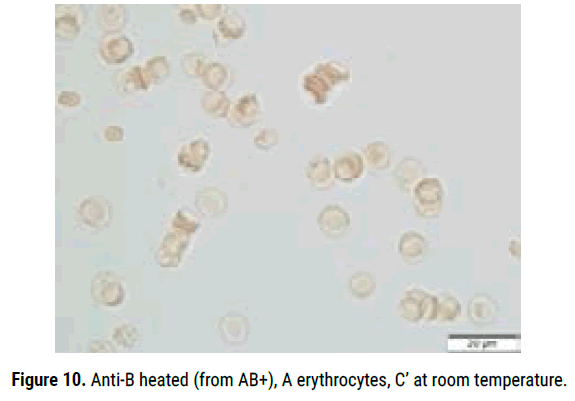
Figure 10: Anti-B heated (from AB+), A erythrocytes, C’ at room temperature.
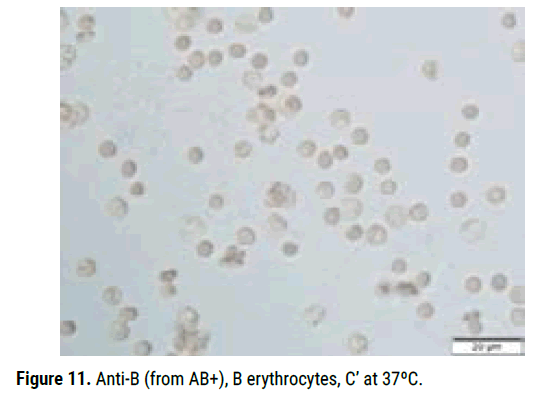
Figure 11: Anti-B (from AB+), B erythrocytes, C’ at 37ºC.
Case 3
BA+ person: The heated serum of BA+ person (with anti-A absorbing ability of erythrocytes) agglutinated OA+ erythrocytes (with anti-A absorbing antigens) at 37°C (Figure 12) (Table 3). The serum showed inhibition of hemagglutination with A erythrocytes after absorbtion with OA+ erythrocytes. The serum of BA+ person did not show inhibition of agglutination being absorbed by O erythrocytes. The heated serum agglutinated A erythrocytes with complement at 37°C (Figure 13).
| Serum | Agglutination at 37°C | Agglutination with C’ at 37°C |
|---|---|---|
| OA+ | A | |
| Anti-A (from BA+) heated | + | + |
Note: C’-Complement.
Table 3: The case of the person with BA+ blood group type.
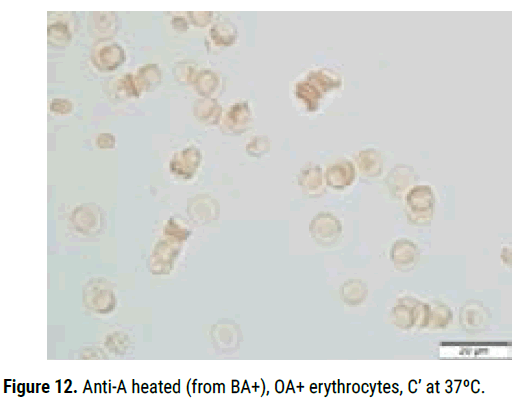
Figure 12: Anti-A heated (from BA+), OA+ erythrocytes, C’ at 37ºC.
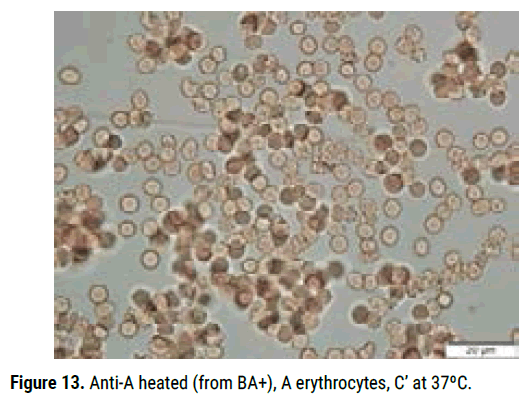
Figure 13: Anti-A heated (from BA+), A erythrocytes, C’ at 37ºC.
Case 4
OA+ B+ person: Agglutination of AB+ (with anti-B absorbing antigens) erythrocytes by OA+B+ (with anti-A, anti-B absorbing antigens) person’s serum with complement at 37°C caused weak hemolysis without agglutination. Weak hemolysis and agglutination were found after incubation of the serum with A erythrocytes and complement at 37°C. Incubation of another person’s heated anti-B serum with B erythrocytes and complement at 4°C, as well as combined with the studied serum caused agglutination. The studied serum agglutinated A erythrocytes at room temperature. The serum of the person did not absorb any antigens of the persons with O blood group. The serum agglutinated B erythrocytes with complement at 37°C (Figure 14).
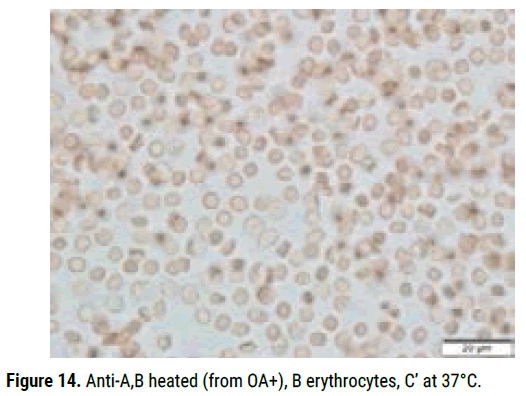
Figure 14: Anti-A,B heated (from OA+), B erythrocytes, C’ at 37°C.
Elution of the antibodies from the person’s erythrocytes after their absorbtion with polyclonal anti-A serum showed the presence of anti-A antibodies.
Interestingly, the contact of the studied erythrocytes with antihelmintic drug fenbendazole decreased the level of anti-A antibodies obtained by elution after the absorbtion of the person’s erythrocytes with anti-A serum.
The authors pointed out that extracts of Ascaris lumbricoides significantly reduce the titer of anti-A antibodies and the Ascaris lumbricoides might possibly be the source of A antigen.
The person’s serum showed high level of antibodies against Ascaris Lumbricoides (1.25 s/co as compared to the normal <1.0 s/co) and Toxocara canis (1.8 s/co, 1:200 as compared to the normal <1.0 s/co). Thus, the decrease of anti-A antibodies in hemagglutination reaction and after elution might be associated with the involvement of hemagglutinins due to Ascaris Lumbricoides infection.
Case 5
AB+ person: The serum of AB+ person (with anti-B absorbing antigens) did not show inhibition of hemagglutination after absorbtion with OB+ erythrocytes (with anti-B absorbing ability), whereas anti-B serum of another person (with A blood group type) showed inhibition of hemagglutination after absorbtion with the same OB+ and another AB+ erythrocytes (with anti-B absorbing ability).
Case 6
BA+ person: Anti-A serum after absorbtion with A erythrocytes reduced agglutination titer on 1 degree. Anti-A serum combined with another anti-A serum further reduced the titer on 2 degrees after absorbtion. Anti-A serum combined with the serum of the person with BA+ blood group type showed further reduction of the titer (Table 4). The titer of hemagglutination of the sera from the persons with different absorbing activity of erythrocytes after absorbtion with A erythrocytes.
| The titer of hemagglutination | 1:2 | 1:4 | 1:8 | 1:16 | 1:32 | 1:64 |
|---|---|---|---|---|---|---|
| Anti-A+A er. | + | + | + | + | +m | +m |
| Anti-A after A er.+A er. | + | + | + | +m | +m | +m |
| Anti-A, another anti-A after A er.+A er. | + | + | + | +m | +m | +m |
| Anti-A and serum of BA+ person after A er.+A er. | + | + | + | +m | +m | - |
Note: er.-Erythrocytes.
Table 4: The titer of hemagglutination of the sera from the persons with different absorbing activity of erythrocytes after absorption with A erythrocytes.
The serum of BA+ person agglutinated A erythrocytes with complement at 37°C (Figure 15) and after absorbtion with B erythrocytes did not reduce the titer of agglutination (increased on 1 degree). Contact of the serum with A erythrocytes at room temperature and complement caused agglutination (Figure 5). The plasma of the studied person agglutinated B erythrocytes with 0.9% NaCl at 37°C. The person’s serum agglutinated A erythrocytes in a 0.9% saline medium at room temperature with a titter 1:16 and did not agglutinate A erythrocytes after absorbtion with the person’s erythrocytes. The serum agglutinated B erythrocytes at room temperature with a titter 1:16 and did note reduce the strength of agglutination after absorbtion with the person’s erythrocytes (Table 5). The person showed high titters of IgG antibodies against Toxocara canis (1:400), Ascaris lumbricoides (1.37 s/co, normal: <1.0), Opistorchis felineus (1.21 s/co, the normal: <1.0).
| Serum | Agglutination at 37°C | Agglutination at RT | Agglutination with C’ at 37°C | Agglutination with C’ at RT |
|---|---|---|---|---|
| B | B | A | A | |
| anti-A (from BA+) | Plasma with NaCl: + | + with NaCl | As compared to another the only heated anti-A: 8.0, 7.4, 7.6 | + |
Table 5: The case of the person with BA+ blood group type.
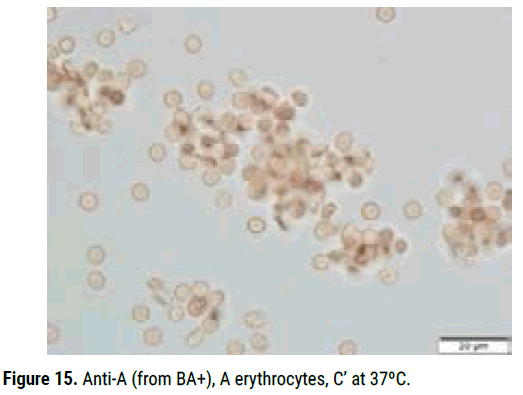
Figure 15: Anti-A (from BA+), A erythrocytes, C’ at 37ºC.
Case 7
OA+ person: The incubation of the heated anti-A serum with A erythrocytes and complement showed the diameter of erythrocytes 7.4, 7.6, 8.0 μm, while contact of the studied OA+ serum (with anti-A absorbing ability) did not enhance the diameter of erythrocytes: 6.5, 6.8 μm (Table 6). Similarly, OA+ serum (with anti-A absorbing antigens) of the other person weakly agglutinated OA+ erythrocytes at room temperature with complement (Figure 16).
| Serum | Agglutination at RT | Agglutination with C’ at RT |
|---|---|---|
| A | A | |
| Anti-A,B (from OA+) heated | + | +, 6.8, 6.5 without complement: 7.8, 7.6 as compared to another the only heated anti-A: 8.0, 7.4, 7.6 |
Table 6: The case of the person with OA+ blood group type.
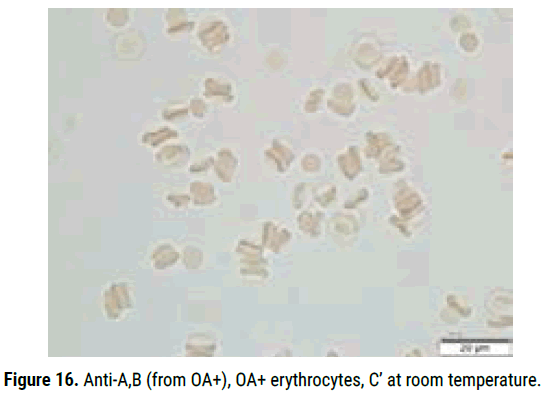
Figure 16: Anti-A,B (from OA+), OA+ erythrocytes, C’ at room temperature.
Incubation of the heated anti-A serum as well as with plasma with complement at room temperature showed agglutination of A erythrocytes.
Case 8
OA+ person: The heated anti-A,B serum from OA+ person (with anti-A absorbing antigens) induced agglutination of A erythrocytes at room temperature (Figure 17) (Table 7). The heated anti-B serum of another person agglutinated and hemolysed AB+ erythrocytes (with anti-B absorbing antigens) with complement at 37°C (Figure 18), whereas combination with the studied OA+ serum did not induce hemolysis in agglutination reaction (Figure 19).
| Serum | Agglutination at RT |
|---|---|
| A | |
| Anti-A, B (from OA+). Heated | With heated anti-B: +. The only heated anti-B: +, hem. |
Note: hem.-Hemolysis.
Table 7: The case of the person with OA+ blood group type.
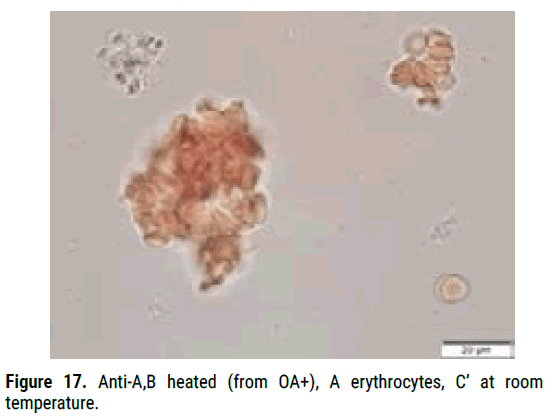
Figure 17: Anti-A,B heated (from OA+), A erythrocytes, C’ at room temperature.
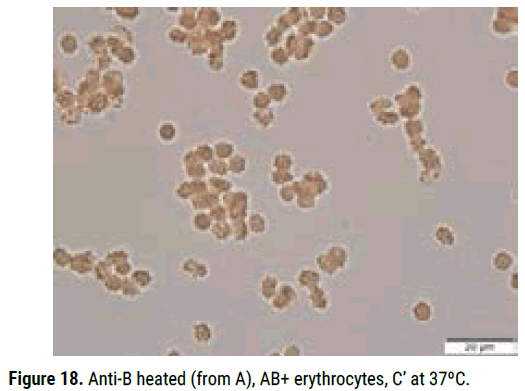
Figure 18: Anti-B heated (from A), AB+ erythrocytes, C’ at 37ºC.
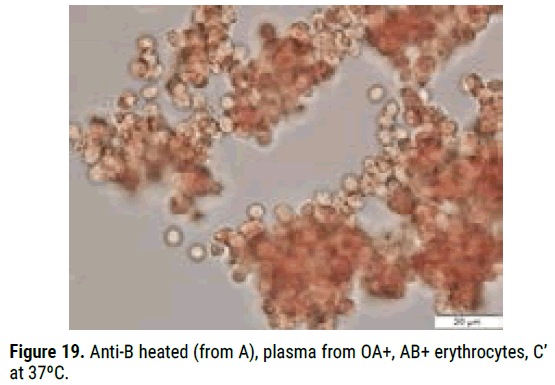
Figure 19: Anti-B heated (from A), plasma from OA+, AB+ erythrocytes, C’ at 37ºC.
Therefore, the obtained data could be present in tables (Tables 8-13).
| The heated serum | Diameter | |
|---|---|---|
| A | B | |
| anti-B (from AB+) | 6.7 | |
| anti-A,B (from OA+) | 6.5, 6.8 | |
| anti-A,B (from O A+B+) | 5.0, 5.1, 6.0 µm (without serum: 5.5, 6.0, 6.5 µm) | |
| anti-A,B (from O A+B+) | 6.4, 6.5, 7.0 µm (without serum: 5.6, 6.4 µm) | |
Table 8: The size of erythrocytes under influence of the heated serum of the same specificity of the persons with different from blood group type absorbing ability of erythrocytes with complement at room temperature (5.0-7.0 μm).
| The heated serum | Diameter | |
|---|---|---|
| A | O | |
| anti-B (from AB+) | 4.7, 4.9, 5.2 | |
| anti-B (from AB+) | 7.3, 8.0 | |
Table 9: The size of erythrocytes of the other specificity after the contact of the heated serum of the persons with different from blood group type absorbing ability of erythrocytes with complement at room temperature (4.7-8.0 μm).
| The heated serum | Diameter | |
|---|---|---|
| A | AB | |
| Anti-A (from B) | 6.1, 7.1, 7.8; 5.1, 5.3, 5.8; 4.4, 6.8, 7,7 | |
| Anti-A (from B) | 7.4, 7.6, 8.0 µm (without serum: 5.0, 5.2, 5.4 µm) | |
| Anti-A (from B) | 5.0, 5.4, 6.1 | |
| Anti-A,B (from O) | 5.3, 8.4, 8.7 | |
Table 10: The size of the erythrocytes under the influence of the heated sera of the same specificity of the persons with absorbing ability concordant with blood group type of erythrocytes with complement at room temperature (4.4-8.7 μm).
| The heated serum | Diameter | ||
|---|---|---|---|
| AB+ | BA+ | OA+B+ | |
| Anti-A (from B) | 4.8, 6.7, 7.5, 8.3 | ||
| Anti-A,B (from B) | 6.0, 6.9 | ||
| Anti-A,B (from B) | 4.6, 5.3 | ||
| Anti-A (from B) | 6.5, 7.0 (without serum: 5.1, 5.7 µm) | ||
| Anti-A (from B) | 5.6, 6.1, 7.8, 8.0 | ||
Table 11: The size of the erythrocytes with additional absorbing antigens under the influence of the usual sera (4.6-8.3 μm).
| The heated serum | Diameter | |
|---|---|---|
| O | AB+ | |
| Anti-A (from B) | 6.1, 6.4, 6.9 (without serum: 5.8 µm); 4.4, 4.6, 4.8 µm |
|
| Anti-A,B (from O) | 5.2, 5.5, 7.3 | |
| Anti-B (from B) | 4.5, 5.0, 7.0, 7.4 |
Table 12: The size of the erythrocytes of the other specificity after the contact with the heated usual sera (4.5-7.4 μm).
| Erythrocytes | Usual serum | Serum from the person with additional absorbing antigens |
|---|---|---|
| Of the same specificity | 4.4-8.7 | 5.0-7.0 |
| Of the other specificity | 4.5-7.4 | 4.7-8.0 |
| With additional absorbing antigens | 4.6-8.3 |
Table 13: Diameter of erythrocytes under the influence of the studied sera (μm).
The study showed the ability of the heated sera from the persons with anti-A and anti-B absorbing ability of erythrocytes corresponding with their blood group type to increase the size of erythrocytes after the incubation with complement at room temperature. The heated sera of the persons with different from their blood group type absorbing ability of erythrocytes did not cause the same increase of the size of erythrocytes after the contact with complement at room temperature. The absence of hemolyzing activity of the serum of the persons with not corresponding to their blood group type anti-A or anti-B absorbing abilities might be explained by the influence of inhibitory factor of absorbtion and hemolysis present in their serum and earlier described in the studies [3-5].
As we can see from the case 1 (AB+ person) the heated serum in the reaction with complement at room temperature showed diameter of B erythrocytes 6.7 μm, of A erythrocytes 8.0 μm and of O erythrocytes 5.2 μm. Plasma from the person with AB+ type decreased the size of AB erythrocytes after adding to the usual (without additional absorbing ability) anti-A,B heated serum (from O blood group type) as compared to the size after the reaction with the only heated anti-A,B serum (8.3 and 10.5 μm accordingly) [6].
The case 2 (from AB+ person) showed the paleness of A erythrocytes after the contact of the heated serum and complement at room temperature.
In the case 3 the serum from BA+ person showed agglutination with OA+ and A erythrocytes, whereas the serum from the case 6 (BA+ blood group) agglutinated B erythrocytes at 37°C.
The serum from O A+B+ person (the case 4) showed possibility to hemolyse A and AB erythrocytes at 37°C after the contact with complement. Interestingly, that the person demonstrated high levels of antibodies against Ascaris lumbricoides and Toxocara canis and ability of the erythrocytes to absorb less anti-A serum in the presence of fenbendazole as we could conclude from the elution.
Importantly, that after anti-B was adsorbed by Pseudomonas aeruginosa, the studied O A+ B+ erythrocytes did not absorb anti-B antibody that could testify of the mimicry of Pseudomonas aeruginosa antigens with B antigen.
The heated serum from OA+ person (the case 7) showed ability to change the size of erythrocytes less than the serum without anti-A absorbing ability of erythrocytes (6.8 and 8.0 μm accordingly).
The serum from OA+ person (the case 8) combined with the usual heated anti-B serum did not increase the size of erythrocytes so much as after the reaction of only the heated anti-B and showed absence of hemolysis of A erythrocytes at room temperature as compared to the only heated anti-B antibody.
The diameter of A erythrocytes under the influence of the heated anti-A serum and complement at room temperature: 6.1-7.8 μm whereas the diameter of erythrocytes after the contact of the serum of OA+ person is 6.8 μm (case 7) (Tables 6, 14 and 15).
| Serum | Agglutination with C’ at RT | |
|---|---|---|
| A | AB | |
| Anti-A (from BA+) heated | 6.1, 7.8, 7.1, with another A er.: 4.4, 7.7, 6.8, with another A er.: 5.3, 5.1, 5.8 (hem) | 6.1, 5.4, 5.0, with another AB er.: 4.8, 5.0, 5.1 |
Note: er.–Erythrocytes; C’-Complement.
Table 14: The case of the person with BA+ blood group type.
| Serum | Agglutination with C’ at RT |
|---|---|
| BA+ | |
| Anti-A heated | 6.5, 7.0, the only BA+ er.: 5.7, 5.2, 5.1 µm |
Note: er.-erythrocytes
Table 15: The case of the person with B blood group type.
Usual anti-B serum at room temperature induced the size of AB+ erythrocytes 5.6-6.1 μm, whereas anti-B serum from AB+ person (the case 1) showed less diameter of A erythrocyte: 4.0-6.2 μm (Table 16).
| Serum | Agglutination at RT |
|---|---|
| AB+ | |
| Anti-B | + 5.6, 6.1, the only AB+ er.: 6.6, 5.9 |
Table 16: The case of the person with A blood group type.
The heated anti-B serum after the contact with complement at room temperature changed AB+ erythrocytes with diameter 4.5-7.4 μm as compared to the heated anti-B from AB+ person (the case 1) is 7.3, 8.0 μm with A erythrocytes and 6.7 μm with B erythrocytes (Table 17).
| Serum | Agglutination at RT | Agglutination with C’ at RT |
|---|---|---|
| AB+ | AB+ | |
| Anti-B | 7.8, 7.4 | |
| Heated | 5.7 | 5.0, 4.5, 7.0, 7.4 |
Table 17: The case of the person with A blood group type.
The contact of anti-B serum and AB+ erythrocytes at room temperature showed diameter 7.4-7.8 μm, whereas anti-B serum (from AB+ person, the case 1) and A erythrocytes is 4.0 μm.
The heated anti-A with A erythrocytes and complement at room temperature: 7.4-8.0 μm, whereas the heated anti-A,B from OA+ person with A erythrocytes is 6.8 μm (Table 18).
| Serum | Agglutination with C’ at 37°C | Agglutination with C’ at RT |
|---|---|---|
| A | A | |
| Anti-A | 7.0, 7.8, pH: 6.0: 6.5, 6.4; pH 8.0: 7.0, 7.4, 5.6, 5.7 | |
| Heated | +8.0, 7.4, 7.6. the only er.- 5.4, 5.0, 5.2 |
Note: er.-Erythrocytes; C’-Complement
Table 18: The case of the person with B blood group type.
The heated anti-A and AB+ erythrocytes (the case 5) with complement at room temperature showed the size of erythrocytes 4.8-8.3 μm, whereas the heated anti-A,B from OA+ person: 6.8 μm with A erythrocytes (Table 19).
| Serum | Agglutination at RT | Agglutination with C’ at RT |
|---|---|---|
| AB+ | AB+ | |
| Anti-A | 6.7, 7.7, 4.2 the only AB+ erythrocytes 6.4, 5.6, 7.2 | |
| Heated | 6.7, 6.8 | 7.5, 6.7, 8.3, 4.8 |
Note: C’-Complement.
Table 19: The case of the person with B blood group type.
The heated anti-A,B with AB+ erythrocytes at room temperature with complement: 6.0-6.9 μm, the heated anti-A,B from OA+ person with A erythrocytes: 6.8 μm (Table 20).
| Serum | Agglutination at RT | Agglutination with C’ at RT |
|---|---|---|
| AB+ | AB+ | |
| Anti-A,B Heated | 5.7, 5.1, 6.1 | 6.9, 6.0 |
Note: C’-Complement.
Table 20: The case of the person with O blood group type.
Anti-A,B at room temperature with O erythrocytes led to the size 4.5- 6.5 μm, at room temperature with the heated serum: 3.7-6.9 μm, whereas anti-B from AB+ person with OA+ erythrocytes at room temperature: 4.0- 6.2 μm (4.9-5.8 μm with the heated serum) (Table 21).
| Serum | Agglutination at RT | Agglutination with C’ at RT | Agglutination with C’ at 4°C | ||
|---|---|---|---|---|---|
| O | AB | O | AB | AB | |
| Anti-A,B | 6.5, 4.5, 5.9 | 7.9, 5.0, 5.1 | Without C’: 6.9, 7.6 | ||
| Heated | 4.0, 3.7, 6.9 | 5.0, 6.9, 7.3 | 5.5, 5.2, 7.3 | 5.3, 8.7, 8.4 | 7.2, 8.9, 10.5 Without C’: 6.6, 7.5, 6.8 |
Note: C’-Complement.
Table 21: The case of the person with O blood group type.
Anti-A,B with AB erythrocytes at room temperature showed the size 5.1-7.9 μm, anti-B from AB+ person with A erythrocytes at room temperature: 4.0-6.2 μm.
The heated anti-A,B led to the size of O erythrocytes 5.2-7.3 μm, the heated plasma from AB+ person led to the size of O erythrocytes 4.7-5.2 μm. The heated anti-A,B with complement at room temperature showed the diameter of AB cells 5.3-8.7 μm, the heated anti-A,B from OA+ person showed less size of A erythrocytes: 6.5-6.8 μm.
The heated serum at room temperature without antibodies (from AB person) with AB+ erythrocytes at room temperature led to the diameter 5.1 μm, the heated serum with complement and AB+ erythrocytes: 4.6-5.3 μm (Table 22).
| Serum | Agglutination at RT | Agglutination with C’ at RT | Agglutination with C at 4°C |
|---|---|---|---|
| AB+ | AB+ | O | |
| From AB person | Without C’:5.0, 6.9, 7.3 | ||
| Heated | 5.1, only AB+ er.: 6.4, 5.6, 7.2 | 5.3, 4.6 |
Note: C’-Complement.
Table 22: The case of the person with AB+ blood group type.
Importantly, the usual heated anti-A,B serum with complement at room temperature increased the diameter of O erythrocytes: 5.2, 5.5, 7.3 μm, the heated anti-B serum from AB+ person showed less diameter: 4.7, 5.2 μm.
Thus, the heat stable antibodies of the usual serum at room temperature with complement increased the size of erythrocytes of the same specificity to 4.4-8.7 μm. Thus, the contact of anti-A and A erythrocytes: 6.1, 7.1, 7.8; 4.4, 6.8, 7.7 μm; 5.1, 5.3, 5.8 μm. The contact of another anti-A and A erythrocytes: 7.4, 7.6, 8.0 μm (whereas the diameter of erythrocytes without serum: 5.0, 5.2, 5.4 μm). The contact of the heated anti-A and AB erythrocytes: 5.0, 5.4, 6.1 μm; 4.8, 5.0, 5.1 μm. The heated anti-A,B and AB erythrocytes: 5.3, 8.4, 8.7 μm. The heated anti-A and AB+ erythrocytes: 4.8, 6.7, 7.3, 7.5, 8.3 μm, the heated anti-A,B and AB+: 6.0, 6.9 μm, the heated anti-A,B of the case and AB+ erythrocytes: 4.6, 5.3 μm.
The usual serum with erythrocytes without antigens induced the size 4.4-7.3 μm. The heated anti-A and O erythrocytes: 6.1, 6.4, 6.9 μm (the erythrocytes without serum: 5.8, 5.9 μm); 4.4, 4.6, 4.8 μm. The heated anti-A,B and O erythrocytes are 5.2, 5.5, 7.3 μm. The usual serum with erythrocytes absorbing antigens different from blood group type showed size: 4.5-7.4 μm (anti-B and AB+: 4.5, 5.0, 7.0, 7.4 μm).
The heated serum with different from blood group absorbing characteristic at room temperature with complement led to the less size of erythrocytes of the same specificity 5.0-7.0 μm. Thus, the heated anti-B (from AB+ person) showed size of B erythrocytes 6.7 μm (without serum: 4.7, 4.8 μm). The heated anti-A,B (from OA+) led to the size of A erythrocytes 6.5, 6.8 μm. The heated anti-A,B (from OA+B+) with complement at room temperature led to the size of A erythrocytes 5.0, 5.1, 6.0 μm (without serum: 5.5, 6.0, 6.5 μm), of B erythrocytes: 6.4, 6.5, 7.0 μm (without serum: 5.6, 6.4 μm). With erythrocytes of the other specificity the heated serum showed increased size: 4.5-7.4 μm. The contact of anti-B (from A,B+) and A erythrocytes showed the size 7.3, 8.0 μm (without serum: 5.6, 7.5 μm), whereas with O erythrocytes less size was detected: 4.7, 4.9, 5.2 μm.
The recognition of a link between red cell antigens and a person’s susceptibility to a particular disease has encouraged in-depth analyses of the individuals with different agglutinating and absorbing ability of erythrocytes.
The discoveries of extracellular hair-like appendages of microorganisms called pili, fimbriae, or (later) adhesions, that are directly related to infectivity, and of the hemagglutinating properties of bacteria that express these extracellular appendages were the first findings related to the bacterial cell-eukaryotic cell interaction. Escherichia coli induced different hemagglutination patterns of both human and animal red cells, which indicated that microorganisms could detect a variety of cell types and, thus, a variety of tissue ligands. Similarly, the use of null phenotype cells for tests of parasitic invasion has contributed greatly to our knowledge of red cell parasites [7].
The present study showed the possibility of sera with positive antibodies against parasites differently influence on red cells diameter as compared to the sera without increased antibodies to Ascaris and Toxocara.
In the field of transfusion medicine, bacteria and viruses are studied generally because of the harm that they cause. However, the study of hemagglutination in the presence of bacteria, viruses, or parasites has contributed, to the understanding of bacterial adhesions and their role in infectivity. These studies are an example of how two scientific fields can combine their knowledge for scientific advancement.
The heated sera of the persons with anti-A or anti-B absorbing abilities of erythrocytes not corresponding to their blood group did not increase so much the size of erythrocytes during incubation with complement at room temperature as compared to the serum of the persons with absorbing abilities of erythrocytes corresponding with blood group type.
Thus, the increase of erythrocytes diameter (4.4-8.7 μm) was accompanied by the action of the serum and erythrocytes of concordant specificity. Diameter of erythrocytes less than 7.4 μm was observed after the contact of the serum and erythrocytes of the opposite specificity. Importantly, that diameter of erythrocytes with additional absorbing antigens was increased under the influence of the usual serum as well (4.6-8.3 μm).
On the contrary, less than 7.0 μm diameters of the erythrocytes was observed under the influence of the serum from the persons with additional absorbing antigens of erythrocytes, whereas diameter of erythrocytes of the other specificity was increased (4.7-8.0 μm).
Citation: Kravchun PG, et al. Clinical Cases of Influence of Anti-A and Anti-B Antibodies on Erythrocyte Membrane with Regard of Absorbing Properties of Erythrocytes. J Biol Today's World, 2021, 10(2), 001-008.
Received: 18-Jan-2021 Published: 08-Feb-2021, DOI: 10.35248/2322-3308.21.10.004
Copyright: © 2021 Kravchun PG, et al. This is an open-access article distributed under the terms of the Creative Commons Attribution License, which permits unrestricted use, distribution, and reproduction in any medium, provided the original author and source are credited.